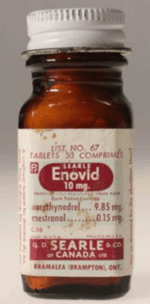Mestranol/noretynodrel
Mestranol/norethynodrel was the first combined oral contraceptive pill (COCP) being mestranol and norethynodrel. It sold as Enovid in the United States and as Enavid in the United Kingdom. Developed by Gregory Pincus at G. D. Searle & Company, it was first approved on June 10, 1957 by the U.S. Food and Drug Administration for treatment of menstrual disorders.[1] The FDA approved an additional indication for use as a contraceptive on June 23, 1960, though it only became legally prescribable nationwide and regardless of the woman's marital status after Eisenstadt v. Baird in 1972.[2][3][4][5] In 1961, it was approved as a contraceptive in the UK and in Canada.[6][7]
 Enovid first came in a bottle. | |
| Combination of | |
|---|---|
| Mestranol | Estrogen |
| Norethynodrel | Progestogen |
| Clinical data | |
| Trade names | Enavid, Enovid |
| Routes of administration | By mouth |
| ATC code | |
| Legal status | |
| Legal status |
|
| Identifiers | |
| PubChem CID | |
| CompTox Dashboard (EPA) | |
Medical uses
Mestranol/noretynodrel was indicated in the treatment of gynecological and menstrual disorders. Originally it was not legal to use contraception so it was marketed for menstrual relief with the side effect of inability to conceive. [8] It has also been used to suppress lactation and to treat endometriosis in women.[9][10]
Available forms
The medication contained 0.15 mg mestranol and 10 mg noretynodrel.[8] Additional formulations containing 0.075 mg mestranol and 5 mg noretynodrel as well as 0.1 mg mestranol and 2.5 mg noretynodrel were subsequently introduced.[8] One formulation also contained 0.075 mg mestranol and 3 mg noretynodrel.[8]
History
The first published case report of a blood clot and pulmonary embolism in a woman using Enavid (Enovid 10 mg in the U.S.) at a dose of 20 mg/day did not appear until November 1961, four years after its approval, by which time it had been used by over one million women.[3][11][12] It would take almost a decade of epidemiological studies to conclusively establish an increased risk of venous thrombosis in oral contraceptive users and an increased risk of stroke and myocardial infarction in oral contraceptive users who smoke or have high blood pressure or other cardiovascular or cerebrovascular risk factors.[13] These risks of oral contraceptives were dramatized in the 1969 book The Doctors' Case Against the Pill by feminist journalist Barbara Seaman who helped arrange the 1970 Nelson Pill Hearings called by Senator Gaylord Nelson.[14] The hearings were conducted by senators who were all men and the witnesses in the first round of hearings were all men, leading Alice Wolfson and other feminists to protest the hearings and generate media attention.[15] Their work led to mandating the inclusion of patient package inserts with oral contraceptives to explain their possible side effects and risks to help facilitate informed consent.[16][17][18] Today's standard dose oral contraceptives contain an estrogen dose that is one third lower than the first marketed oral contraceptive and contain lower doses of different, more potent progestins in a variety of formulations.[13][15][19]
Enovid was discontinued in the U.S. in 1988, along with other first-generation high-estrogen COCPs.[20][21]
See also
References
- White Junod, Ph.D., Suzanne (1998). "FDA's Approval of the First Oral Contraceptive, Enovid". Histories of Product Regulation. Update (bimonthly publication of the Food and Drug Law Institute). U.S. Food and Drug Administration.
- "FDA Approved Drug Products". FDA.
- Junod, S. W.; Marks, L (2002). "Women's trials: the approval of the first oral contraceptive pill in the United States and Great Britain" (PDF). Journal of the History of Medicine and Allied Sciences. 57 (2): 117–60. doi:10.1093/jhmas/57.2.117. PMID 11995593.
- Tone, Andrea (2001). Devices & Desires: A History of Contraceptives in America. New York: Hill and Wang. ISBN 0-8090-3817-X.
- Watkins, Elizabeth Siegel (1998). On the Pill: A Social History of Oral Contraceptives, 1950–1970. Baltimore: Johns Hopkins University Press. ISBN 0-8018-5876-3.
- "ANNOTATIONS". Br Med J. 2 (5258): 1007–9. October 14, 1961. doi:10.1136/bmj.2.3490.1009. PMC 1970146. PMID 20789252.
- "Medical News". Br Med J. 2 (5258): 1032–1034. October 14, 1961. doi:10.1136/bmj.2.5258.1032. PMC 1970195.
- Lara Marks (2010). Sexual Chemistry: A History of the Contraceptive Pill. Yale University Press. pp. 75, 77–78. ISBN 978-0-300-16791-7.
- Helmuth Vorherr (2 December 2012). The Breast: Morphology, Physiology, and Lactation. Elsevier Science. pp. 202–. ISBN 978-0-323-15726-1.
- David Olive (29 November 2004). Endometriosis in Clinical Practice. CRC Press. pp. 246–. ISBN 978-0-203-31939-0.
- Winter IC (March 1965). "The incidence of thromboembolism in Enovid users". Metabolism. 14 (Supplement): 422–428. doi:10.1016/0026-0495(65)90029-6. PMID 14261427.
- Jordan WM, Anand JK (November 18, 1961). "Pulmonary embolism". Lancet. 278 (7212): 1146–1147. doi:10.1016/S0140-6736(61)91061-3.
- Marks, Lara (2001). Sexual Chemistry: A History of the Contraceptive Pill. New Haven: Yale University Press. ISBN 0-300-08943-0.
- Seaman, Barbara (1969). The Doctors’ Case Against the Pill. New York: P. H. Wyden. ISBN 0-385-14575-6.
- Watkins, Elizabeth Siegel (1998). On the Pill: A Social History of Oral Contraceptives, 1950–1970. Baltimore: Johns Hopkins University Press. ISBN 0-8018-5876-3.
- FDA (June 11, 1970). "Statement of policy concerning oral contraceptive labeling directed to users". Federal Register. 35 (113): 9001–9003.
- FDA (January 31, 1978). "Oral contraceptives; requirement for labeling directed to the patient". Federal Register. 43 (21): 4313–4334.
- FDA (May 25, 1989). "Oral contraceptives; patient package insert requirement". Federal Register. 54 (100): 22585–22588.
- Speroff, Leon; Darney, Philip D. (2005). "Oral Contraception". A Clinical Guide for Contraception (4th ed.). Philadelphia: Lippincott Williams & Wilkins. pp. 21–138. ISBN 0-7817-6488-2.
- Reuters News Service (1988-04-15). "Searle, 2 others to stop making high-estrogen pill". St. Louis Post-Dispatch. pp. 7D. Retrieved 2009-08-29.
- "High-estrogen 'pill' going off market". San Jose Mercury News. 1988-04-15. Retrieved 2009-08-29.
External links
- Snider, Sharon. "The Pill: 30 Years of Safety Concerns". FDA Consumer. Rockville, MD: U.S. Food and Drug Administration (December 1990): 9–11. OCLC 25936326.